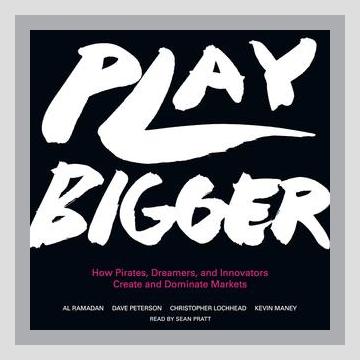Entrepreneurship and StartupsEntrepreneurial MindsetScaling Up
Summary of “Play Bigger: How Pirates, Dreamers, and Innovators Create and Dominate Markets”
Title: Play Bigger: How Pirates, Dreamers, and Innovators Create and Dominate Markets\
Authors: Al Ramadan, Dave Peterson, Christopher Lochhead, Kevin Maney\
Published: 2016\
Categories: Scaling Up, Entrepreneurial Mindset
Introduction
“Play Bigger” is a guide on how to become a market leader and create entirely new market categories. The authors, a group of successful entrepreneurs and strategists, outline the concept of category design and provide a blueprint for establishing dominance in an industry by creating and claiming new market spaces. The book is rich with concrete examples and actionable advice.
Key Concepts and Actionable Insights
1. Category Design
Concept: Category design is the process of defining, developing, and ultimately owning a new market category. This is deeper than simply innovating a product; it’s about establishing a novel kind of value in the minds of potential customers.
Action: Identify an unmet need in the market and conceptualize a new category. Formulate a clear and compelling narrative that explains why this category is both new and necessary.
Example: Marc Benioff of Salesforce.com not only launched a new product but also created the category of “cloud computing” for customer relationship management (CRM). By doing so, Salesforce became synonymous with this new category.
2. The Power of a Point of View (POV)
Concept: A powerful and distinctive POV is essential for category design. It defines the problem in a new way that resonates with customers and positions your solution uniquely.
Action: Craft a strong POV by framing the problem from the customer’s perspective and setting your solution as the hero. Make sure your POV is simple to understand and communicate.
Example: GoPro’s POV redefined personal video cameras. Nick Woodman created the notion that GoPro was not just a camera but a way to capture life’s exciting moments from the user’s perspective.
3. Leveraging Category Kings
Concept: Category kings are companies that do not just participate in markets but dominate them. These companies capture the majority of mindshare, market share, and create financial value.
Action: Aim to be a category king by aggressively and consistently communicating your POV and ensuring that your category benefits customers significantly more than existing options.
Example: Apple’s creation of the smartphone category with the launch of the iPhone. Apple didn’t just enter an existing market; it redefined the category by integrating a phone, an iPod, and an internet communicator into one device.
4. Category Ecosystem
Concept: A thriving category arises from a well-orchestrated ecosystem that includes customers, partners, developers, and even competitors.
Action: Foster relationships within your industry ecosystem to support your category. Collaborate with partners to create complementary products and services that enhance the overall category value.
Example: Facebook’s development of its platform by engaging third-party developers to create applications that would run on Facebook, thereby enriching the user experience and strengthening the social networking category.
5. Lightning Strikes
Concept: Creating intense, strategic bursts of marketing activity—referred to as “lightning strikes”—is essential to gaining traction in a new category.
Action: Design and execute coordinated, high-impact marketing campaigns that attract significant attention in a short period. Use these campaigns to propagate your POV and establish your brand’s dominance in the category.
Example: Uber’s aggressive launch campaigns in new cities were designed to create maximum visibility and user acquisition quickly, disrupting traditional taxi services.
6. Measuring Category Potential
Concept: Understand the size of the potential category and how to measure its emergence and growth. This includes assessing the pervasiveness of the need and the readiness of the market.
Action: Conduct market research to evaluate the potential size and growth rate of the proposed category. Use metrics such as Total Addressable Market (TAM) to justify the investment and effort in category creation.
Example: Airbnb assessed the huge unmet demand in the lodging industry and pioneered a new category of “home-sharing” by tapping into a previously overlooked market segment.
7. Data Flywheel
Concept: The data flywheel effect occurs when companies use data collected from users to continually enhance their products, thereby gaining a competitive advantage and reinforcing their category leadership.
Action: Build data collection and analysis into your product offering to continually improve and differentiate your offering from competitors. This also helps in creating barriers to entry.
Example: Netflix leveraged user data to refine its recommendation algorithms, significantly enhancing user experience and reinforcing its dominance in the online streaming category.
8. Cultural Buzz
Concept: Creating a buzz around your category is essential for its acceptance and growth. This involves not just traditional marketing but also engaging with cultural trends and media.
Action: Engage in content marketing, influencer collaborations, and social media campaigns that align with broader cultural discussions to amplify your category’s presence.
Example: Tesla does not spend much on traditional advertising but generates enormous buzz through its innovative product launches, Elon Musk’s media presence, and significant social media activity.
9. Resilience and Adaptability
Concept: Successfully establishing and maintaining a new category requires resilience and the ability to adapt to changes in the market landscape.
Action: Continuously monitor the market and be ready to pivot or adapt strategies as necessary. Maintain a long-term vision but be flexible in your approach.
Example: Twitter adapted from its original concept as a podcasting platform to a microblogging service, responding to user behavior and demand to become the social media giant it is today.
Conclusion
“Play Bigger” offers a comprehensive framework for aspiring entrepreneurs and businesses to create and dominate new market categories. The concepts of category design, a distinctive POV, leveraging category kings, and fostering a category ecosystem form the foundation of the strategy. By executing intense marketing campaigns, understanding category potential, leveraging data, creating cultural buzz, and remaining adaptable, companies can achieve long-term success and market dominance. The book emphasizes thinking beyond mere product development to shaping entire markets, turning innovative ideas into enduring category kings.
Entrepreneurship and StartupsEntrepreneurial MindsetScaling Up
